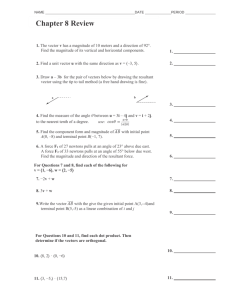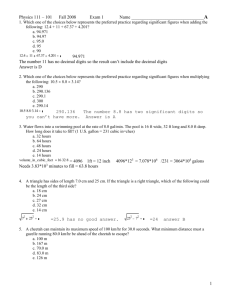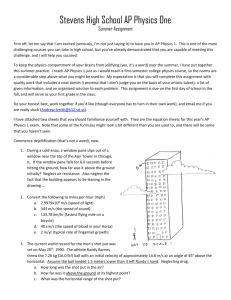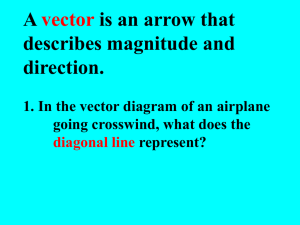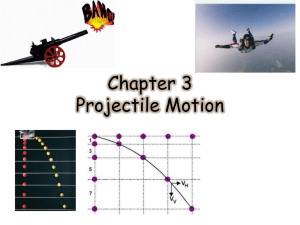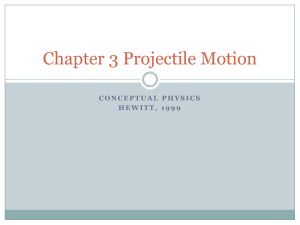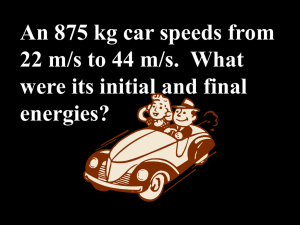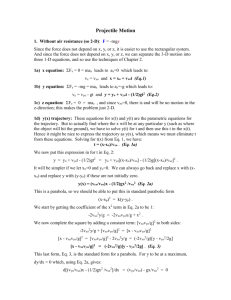Physics
advertisement
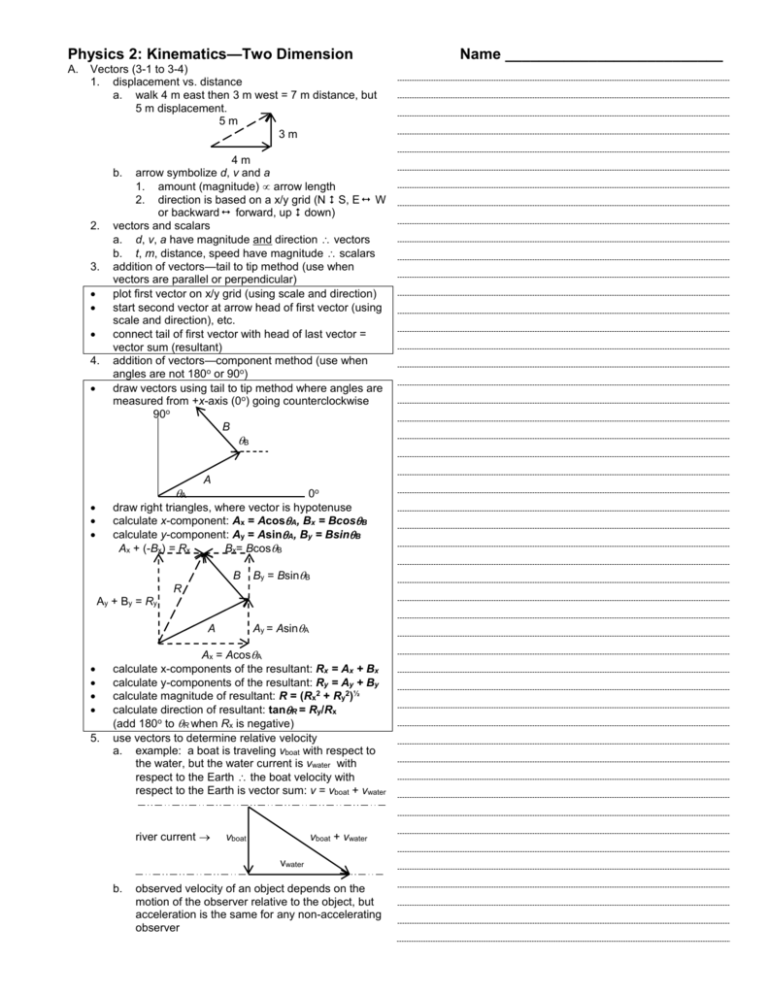
Physics 2: Kinematics—Two Dimension A. Vectors (3-1 to 3-4) 1. displacement vs. distance a. walk 4 m east then 3 m west = 7 m distance, but 5 m displacement. 5m 3m 4m arrow symbolize d, v and a 1. amount (magnitude) arrow length 2. direction is based on a x/y grid (N S, E W or backward forward, up down) vectors and scalars a. d, v, a have magnitude and direction vectors b. t, m, distance, speed have magnitude scalars addition of vectors—tail to tip method (use when vectors are parallel or perpendicular) plot first vector on x/y grid (using scale and direction) start second vector at arrow head of first vector (using scale and direction), etc. connect tail of first vector with head of last vector = vector sum (resultant) addition of vectors—component method (use when angles are not 180o or 90o) draw vectors using tail to tip method where angles are measured from +x-axis (0o) going counterclockwise 90o B b. 2. 3. 4. B A A 0o draw right triangles, where vector is hypotenuse calculate x-component: Ax = AcosA, Bx = BcosB calculate y-component: Ay = AsinA, By = BsinB Ax + (-Bx) = Rx Bx= BcosB B By = BsinB R Ay + By = Ry Ay = AsinA A 5. Ax = AcosA calculate x-components of the resultant: Rx = Ax + Bx calculate y-components of the resultant: Ry = Ay + By calculate magnitude of resultant: R = (Rx2 + Ry2)½ calculate direction of resultant: tanR = Ry/Rx (add 180o to R when Rx is negative) use vectors to determine relative velocity a. example: a boat is traveling vboat with respect to the water, but the water current is vwater with respect to the Earth the boat velocity with respect to the Earth is vector sum: v = vboat + vwater river current vboat vboat + vwater vwater b. observed velocity of an object depends on the motion of the observer relative to the object, but acceleration is the same for any non-accelerating observer Name __________________________ B. Projectile Motion (3-5 to 3-6) 1. horizontal velocity is unaffected by gravity constant 2. vertical velocity is immediately affected by the downward acceleration of gravity 3. solving projectile motion problems a. general solution determine vxo = vocos and vyo = vosin complete the "y" row in the data chart for all values in the vertical direction ( is negative) complete the "x" row in the data chart for all values in the horizontal direction (vxo = vx) time is the same for y and x directions d vo v a t direction dy vyo vy y -10 m/s2 t dx vxo x solve for unknown in the vertical direction with dy = vyot + ½at2 vy = vyo + at vy2 = vyo2 + 2ady no vy no dy no t solve for unknown in the x direction with dx = vxt b. projectile launched horizontally from height h data chart d vo v a t direction -h 0 vy y -10 m/s2 t dx vo = vxo x solve for unknown in the vertical direction with h = ½at2 vy = at vy2 = 2ah solve for unknown in the x direction with dx = vxt c. projectile launched at angle o from height 0 determine vxo = vocoso and vyo = vosino data chart—highest point d vo v a t direction dy vyo 0 y -10 m/s2 t dx vxo x solve for unknown in the vertical direction with vyo = at 0 = vyo2 + 2ady no dy no t solve for unknown in the x direction with dx = vxt data chart—landing point d vo v a t direction 0 vyo -vyo y -10 m/s2 t dx vxo x solve for unknown in the vertical direction with 2vyo = at solve for unknown in the x direction with dx = vxt d. projectile launched at angle o from height h determine vxo = vocoso and vyo = vosino data chart—landing point d vo v a t direction dy vyo vy y -10 m/s2 t dx vx x solve for unknown in the vertical direction with dy = vyot + ½at2 vy = vyo + at vy2 = vyo2 + 2ady no vy no dy no t solve for unknown in the x direction with dx = vxt c. Experiments 1. Adding Vectors a. Measure the magnitude and angle of vector A and B Calculate the following from the data. Formula Calculation vxo vxo = dx/t vyo dy = vyot + ½at2 vo vo = (vxo2 + vyo2)½ tan = vyo/vxo B A Magnitude (L) Vector A Angle () Practice Problems A. Vectors If two vectors A + B = 0, what can you say about the magnitude and direction of the two vectors? (A) perpendicular (B) parallel in the opposite direction (C) parallel in the same direction Given vectors A + B = C and |A|2 + |B|2 = |C|2, how are the vectors A and B oriented with respect to each other? (A) perpendicular (B) parallel in the opposite direction (C) parallel in the same direction 3. Given vectors A + B = C and |A| + |B| = |C|, how are the vectors A and B oriented with respect to each other? (A) perpendicular (B) parallel in the opposite direction (C) parallel in the same direction 4. If each component of a vector is doubled, what happens to the angle of the vector? (A) doubles (B) the same (C) reduced by half 5. If each component of a vector is equal in length, what is the angle of the vector? (A) 30o (B) 45o (C) 60o (D) 30o or 60o 6. If one of the components is half the length of the vector, what is the angle of the vector? (A) 30o (B) 45o (C) 60o (D) 30o or 60o Questions 7-8 Vx = 30 units Vy = 40 units. 7. What is the magnitude of the resultant V? (A) 30 units (B) 40 units (C) 50 units (D) 70 units 8. What is the angle of the resultant V? (A) 37o (B) 45o (C) 53o (D) 37o or 53o 9. You are adding vectors of length 20 units and 40 units. What is the only possible resultant magnitude? (A) 0 (B) 18 (C) 37 (D) 64 Questions 10-11 Two students are tossing a ball back and forth in the aisle of a train. The velocity of the ball is vB and the velocity of the train is vT. 10. What is the velocity of the ball with respect the ground if the velocities of the ball and train are in the same direction? (A) vB + vT (B) vB – vT (C) 0 11. What is the velocity of the ball with respect the ground if the velocities of the ball and train are in the opposite direction? (A) vB + vT (B) vB – vT (C) 0 12. A student jogs 100 m at 60o north of east. What are the xand y-components of the displacement vector? B b. Calculate the x- and y-components of the two vectors and 1. then add the x-components to determine the resultant x-component and repeat with the y-components. x-component y-component Vector A 2. B R c. Calculate the magnitude and angle of the resultant. Vector magnitude direction R d. Draw the resultant vector on the diagram and measure its magnitude and angle. Vector Magnitude Angle R e. Determine the percent deviation between the two. Magnitude Angle 2. Catapult Lab a. Determine the optimum settings (listed below) for the ping-pong ball catapult by measuring the distance in the air. L1: length of arm from rubber band to axel L2: length of arm from cup to axel : launch angle A: rubber band anchor Distance L1 L2 A 1 2 3 Avg 1 4 8 11 2 4 8 11 3 4 8 11 5 8 11 6 8 11 7 8 11 9 11 max range # max range # 10 11 max 12 range 13 # Launch the ping-pong ball using the maximum settings and measure the time and distance that the ball is in the air. Also measure the height from the launch arm cup to the ground when the ball is launched. dy 1 2 3 Avg b. t dx 13. Determine the resultant for each situation below. magnitude direction 6m+8m 6m+8m 6m+8m 14. a. Label the x-y grid below: (1) north, south, east, west (2) 0o, 90o, 180o, and 270o Draw a displacement vector of 20 m 30o north of east (1 cm = 10 m scale) b. b. What is the resultant velocity of the boat in the water? c. What is the direction of the boat with respect to Earth? d. How much time did it take Alice to cross the river? e. How far down stream did the boat travel? 15. Consider the following vectors, A and B. A B Vector 8.0 cm 4.0 cm Magnitude 25o 150o Angle a. Calculate the x-component and y-component of each vector and then determine the x-component and ycomponent of the resultant R. x-component y-component Vector 19. Bill directs his boat north east but ends up going east. a. Label vboat, vwater and vboat + vwater. b. What is the resultant velocity of the boat in the water? c. What is the direction that Bill heads the boat? d. How much time did it take to cross the river? A B R b. Calculate the magnitude and angle of the resultant. Magnitude Angle 16. Consider the following vectors, A, B and C. a. Calculate the x- and y-component of vectors A, B and C and then determine the resultant's components. Vector Magnitude Angle x-component y-component A 12 cm 45o B 8 cm 135o C 10 cm -75o R b. Calculate the magnitude and angle of the resultant. Vector magnitude direction R 17. A boat travels at 1.85 m/s (vboat) in a river whose current (vwater) is 1.20 m/s west. Determine the velocity of the boat with respect to the ground for each situation. a. the boat is headed due east? b. the boat is headed due north? Questions 18-19 Alice and Bill wish to cross a river, which is 800 m wide with a current of 3 m/s south (vwater) in boats with a maximum speed of 4 m/s (vboat) 18. Alice directs her boat east but ends up going south east. a. Label vboat, vwater and vboat + vwater. 20. A FedEx plane travels from New York to Los Angeles (4,000 km), stays in LA for 90 minutes to refuel and unload and reload cargo, and then returns to NY. The plane's air speed is 800 km/hr and the west to east wind current is 100 km/hr. How long does it take for the round trip? B. Projectile Motion 21. A small cart is rolling a constant velocity on a flat track. It fires a ball straight up into the air as it moves. In relation to the cart, the ball lands (A) In front (B) in the cart (C) behind 22. A small cart accelerates on a flat track. It fires a ball straight up into the air as it speeds up. In relation to the cart, the ball lands (A) In front (B) in the cart (C) behind 23. You drop a package from a plane flying at constant speed in a straight line. Without air resistance, the package will (A) lag behind the plane as it falls (B) remain directly beneath the plane as it falls (C) move ahead of the plane as it falls 24. A projectile is launched at an angle of 30o. At what point in its trajectory does the projectile have the lowest speed? (A) at the start (B) at the middle (C) at the end Questions 25-26 From the same height and at the same time, ball A is dropped and ball B is fired horizontally. 25. Which ball will land first? (A) A (B) B (C) tie 26. Which ball has the greater velocity when it lands? (A) A (B) B (C) tie 27. Which punt has the longest hang time, or do they tie? A B C 28. Which throw from the outfield will reach second base first? A B second base 29. The two identical projectiles use the same launcher. Path A takes place on Earth and path B on the Moon, where g is 1/6 Earth's. A B Which accounts for the greatest difference between the two paths? (A) The initial velocity on the Moon is greater than Earth. (B) The downward acceleration on the Moon is less than Earth. (C) The airless environment on the Moon allows for the horizontal velocity to remain constant. 30. A carnival game includes a gun and a hanging target, which is released at the instant the gun is discharged. In order to strike the target you should aim (A) above the target (B) at the target (C) below the target 31. Label velocity and acceleration vectors at each dot along the projectile path for each situation. a. ball is thrown horizontally from above ground. 33. A rescue plane (traveling horizontally at 70 m/s) wants to drop supplies to climbers on a rocky ridge 235 m below. a. Complete the chart d vo v a t y x b. How long does it take for the supplies to fall 235 m? c. How far in advance must the supplies be dropped? d. What is the line of sight angle from the plane to ridge? e. What is the vertical velocity, vy? f. With what speed do the supplies land? 34. A ball is thrown from the top of a 20 m building with an initial velocity of 10 m/s at various angles. Complete the charts. a. The ball is thrown at 0o (horizontally). d vo v a t y x vy t dx v b. The ball is thrown at 90o (straight up). d vo v a t The ball is thrown at -90o (straight down). d vo v a t The ball is thrown at 37o (above the horizontal). d vo v a t y x b. ball is kicked from ground level at an angle of 60 o. vy t c. y x vy 32. A ball is thrown horizontally at 10 m/s from a bridge that is 20 m above the water. a. Complete the chart d vo v a t y t d. y x x b. How long does it take for the ball to hit the water? c. How far horizontally does the ball travel? vy t dx v 35. A soccer ball is kicked 20 m/s at an angle of 30o. a. Determine the x- and y- components of the velocity vo? vxo vyo b. Complete the chart for the ball when it lands. d vo v a d. e. x a. How long does it take for the supplies to fall 125 m? b. How far in advance must the supplies be dropped? c. What is the line of sight angle from the plane to ridge? d. What is the vertical velocity vyt e. With what speed do the supplies land? t y x c. 38. A rescue plane, traveling horizontally at 100 m/s, wants to drop supplies to climbers on a rocky ridge 125 m below. d vo v a t y What is the total time in the air? What is the total distance the ball travels horizontally? Complete the chart for the ball at its highest point. d vo v a t y x f. 39. A soccer ball is kicked 30 m/s at an angle of 60o. a. Determine the x- and y- components of the velocity vo. What is the maximum height? vxo g. Graph the following. Displacement Horizontal t Velocity vyo Acceleration t t b. Complete the chart for the ball when it lands. d vo v a t y Vertical t t 36. A projectile, fired with velocity vo and angle , lands on a cliff, which is 195 m away and 155 m high, in 7.6 s. a. Complete the chart d vo v a t y x b. What is vxo? c. What is vyo? d. What is vo? e. What is ? 37. A ball is thrown horizontally at 20 m/s from a bridge that is 80 m above the water. d vo v a t y x a. How long does it take for the ball to hit the water? b. How far horizontally does the ball travel? t x c. What is the total time in the air? d. What is the total distance the ball travels horizontally? e. What is the maximum height? 40. A student throws a ball that lands on a cliff 60 m away and 20 m above the student. The ball is in the air for 4 s. d vo v a t y x Determine the following for the ball's initial velocity a. horizontal component b. vertical component c. magnitude d. direction Practice Multiple Choice Briefly explain why the answer is correct in the space provided. 1. A machine launches a tennis ball at an angle = 25° above the horizontal at an initial velocity vo = 14 m/s. Which combination of changes must produce an increase in time of flight of a second launch? (A) decrease and vo (B) decrease and increase vo (C) increase and vo (D) increase and decrease vo 2. 3. Two spheres, A and B, are thrown horizontally from the top of a tower; vA = 40 m/s and vB = 20 m/s. Which is true of the time T in the air and horizontal distance d traveled? (A) TA = TB, dA = dB (B) TA = TB, dA = 2dB (C) TA = TB, 2dA = dB (D) TA > TB, dA > dB A plane flying horizontally at 100 m/s drops a crate. What is the horizontal component of the crate's velocity just before it strikes the ground 3 seconds later? (A) 0 m/s (B) 100 m/s (C) 300 m/s (D) 400 m/s Questions 4-5 A ball is launched horizontally at 5 m/s from a height of 10 m. 10 m How much time is the ball in the air? (A) 0.5 s (B) 0.7 s (C) 1.4 s (D) 2 s 5. How far does the ball travel horizontally before hitting the ground? (A) 2.5 m (B) 5 m (C) 7 m (D) 10 m 6. A projectile is fired with initial velocity, vo, at an angle o. Which pair of graphs represent the vertical components of the velocity vy and acceleration ay of the projectile as functions of time t? (A) vy ay (B) vy ay t (C) vy t ay t t (D) vy t 8. How long is the projectile in the air (assume the projectile lands at the same elevation that it was fired)? (A) 25 s (B) 30 s (C) 45 s (D) 50 s 9. What is the horizontal component of the initial velocity? (A) 100 m/s (B) 150 m/s (C) 200 m/s (D) 250 m/s 10. How far did the projectile travel horizontally before it struck the ground? (A) 6,000 m (B) 7,000 m (C) 9,000 m (D) 10,000 m 11. A projectile is fired with an initial velocity of 100 m/s at an angle above the horizontal. If the projectile's initial horizontal speed is 60 m/s, then angle measures (A) 30o (B) 37o (C) 40o (D) 53o 12. A rock is dropped from the top of a 45-m tower, and at the same time a ball is thrown from the top of the tower in a horizontal direction. The ball and the rock hit the level ground a distance of 30 m apart. The horizontal velocity of the ball thrown was most nearly (A) 5 m/s (B) 10 m/s (C) 15 m/s (D) 20 m/s 5 m/s 4. Questions 7-10 A projectile is fired from the ground with an initial velocity of 250 m/s at an angle of 37o above horizontal. 7. What is the vertical component of the initial velocity? (A) 100 m/s (B) 150 m/s (C) 200 m/s (D) 250 m/s t 13. A projectile is fired from the surface of the Earth with a speed of 200 m/s at an angle of 30° above the horizontal. If the ground is level, what is the maximum height reached by the projectile? (A) 5 m (B) 10 m (C) 500 m (D) 1,000 m 14. How much time is a rock in the air if it is thrown horizontally off a building from a height h with a speed vo? (A) (hvo)½ (B) h/vo (C) hvo/g (D) (2h/g)½ 15. A spring-loaded dart gun generates velocity vo. What is the maximum height h reached by the dart if the gun is pointed at 30o above the horizontal? (A) vo2/4g (B) vo/2g (C) vo2/8g (D) vo/g 16. Vectors V1 and V2 have equal magnitudes and represent the velocities of an object at times t1 and t2, respectively. ay t t The direction of acceleration between time t1 and t2 is (A) (B) (C) (D) Questions 17-18 A person on the west side of a river, which runs north to south, wishes to cross the 1-km wide river to a point directly across from his starting point. The river current is 3 km/hr and the boat's maximum speed is 5 km/hr. 17. What direction should the person direct the boat? (A) due east (B) due north (C) 37o north of east (D) 53o north of east Suppose, instead, that the plane releases the supplies a horizontal distance of 425 m in advance of the climbers. What vertical velocity (up or down) is given to the supplies so that they reach the climbers? 18. How long will it take to reach the dock? (A) 1/5 hr (B) 1/4 hr (C) 1/2 hr (D) 1 hr 19. A stationary observer on the ground sees a package falling with speed v1 at an angle to the vertical. At the same time, a pilot flying horizontally at constant speed relative to the ground sees the package fall vertically with speed v2. What is the speed of the pilot relative to the ground? (A) v1 + v2 (B) v1 – v2 (C) v2 – v1 (D) (v12 – v22)½ 3. Practice Free Response 1. A physics student kicks a ball across the football field. It travels 50 m in 3.2 seconds. a. What is the x-component of the initial velocity? b. What is the y-component of the initial velocity? c. What are the initial velocity's magnitude and direction? d. Graph the following. dx vx t dy 2. How much time is the package in the air? d. What is the package's initial velocity? A boy aims a water-balloon slingshot at a second boy, who is hanging from a tree that is 10 m away. The balloon is launched with velocity, vo = 20 m/s at an angle o = 15o at the same time the second boy drops from the tree. ax t vy t c. a. What are the horizontal and vertical components of the balloon's initial velocity? b. How long does it take the balloon to reach the second boy? c. How far did the second boy fall before he was hit by the balloon? d. What is the balloon's velocity when it strikes the second boy? t ay t t A rescue plane, traveling horizontally at 70 m/s, drops supplies to mountain climbers on a rock ridge 235 m below. a. How much time is the package in the air? b. How far in advance, x, are the supplies dropped?


